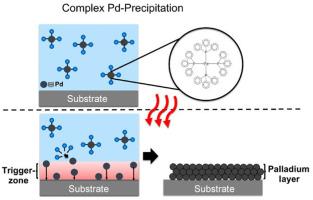Formation and deposition of palladium particles via thermal decomposition of tetrakis(triphenylphosphine)palladium(0)
IF 4.3
2区 材料科学
Q2 ENGINEERING, CHEMICAL
引用次数: 0
Abstract
In this study, a novel wet-chemical approach for formation and in situ deposition of monodisperse palladium particles via thermal decomposition of tetrakis(triphenylphosphine)palladium(0) is presented. These have a size of 532 ± 56 nm and can be produced in solution with subsequent gravimetric deposition on arbitrary support materials. A systematic approach was undertaken to understand the key decomposition parameters, including temperature, heating time, agglomeration time, and precursor concentration. Successful particle formation was achieved by applying temperatures from 40 to 80 °C for at least 1 h. The optimal temperature program for particle formation with high yield depends on the precursor concentration and varies between 1 and 18 h at 40–80 °C. Deeper insights into the interplay between the relevant process conditions were obtained via Design of Experiments using Box-Behnken Design and one-way Analysis of Variance (ANOVA). The obtained correlations between the experimental parameters demonstrate the complexity of the system and form the basis for further optimizations to potentially even use this system as a novel coating technique.

四(三苯基膦)钯(0)热分解过程中钯颗粒的形成与沉积
在这项研究中,提出了一种新的湿化学方法,通过热分解四(三苯基膦)钯(0)形成和原位沉积单分散钯颗粒。它们的尺寸为532±56 nm,可以在溶液中生产,随后在任意支撑材料上进行重量沉积。采用系统的方法来了解分解的关键参数,包括温度、加热时间、团聚时间和前驱体浓度。通过在40 - 80℃温度下至少1小时,可以成功形成颗粒。高产量颗粒形成的最佳温度程序取决于前驱体浓度,在40 - 80℃温度下在1 - 18小时之间变化。通过使用Box-Behnken设计和单因素方差分析(ANOVA)进行实验设计,深入了解相关工艺条件之间的相互作用。获得的实验参数之间的相关性表明了系统的复杂性,并为进一步优化奠定了基础,甚至可能将该系统用作一种新的涂层技术。
本文章由计算机程序翻译,如有差异,请以英文原文为准。
求助全文
约1分钟内获得全文
求助全文
来源期刊

Particuology
工程技术-材料科学:综合
CiteScore
6.70
自引率
2.90%
发文量
1730
审稿时长
32 days
期刊介绍:
The word ‘particuology’ was coined to parallel the discipline for the science and technology of particles.
Particuology is an interdisciplinary journal that publishes frontier research articles and critical reviews on the discovery, formulation and engineering of particulate materials, processes and systems. It especially welcomes contributions utilising advanced theoretical, modelling and measurement methods to enable the discovery and creation of new particulate materials, and the manufacturing of functional particulate-based products, such as sensors.
Papers are handled by Thematic Editors who oversee contributions from specific subject fields. These fields are classified into: Particle Synthesis and Modification; Particle Characterization and Measurement; Granular Systems and Bulk Solids Technology; Fluidization and Particle-Fluid Systems; Aerosols; and Applications of Particle Technology.
Key topics concerning the creation and processing of particulates include:
-Modelling and simulation of particle formation, collective behaviour of particles and systems for particle production over a broad spectrum of length scales
-Mining of experimental data for particle synthesis and surface properties to facilitate the creation of new materials and processes
-Particle design and preparation including controlled response and sensing functionalities in formation, delivery systems and biological systems, etc.
-Experimental and computational methods for visualization and analysis of particulate system.
These topics are broadly relevant to the production of materials, pharmaceuticals and food, and to the conversion of energy resources to fuels and protection of the environment.
 求助内容:
求助内容: 应助结果提醒方式:
应助结果提醒方式:


